- Home
- Garden Wildlife
- Molluscs
- Pond snails
Shell of wandering snail Radix balthica Shell of bladder snail Physa fontinalis
The last species we are covering is the 12-15mm mud snail Bithynia tentaculata. All the other species so far have been "pulmonates" - the group of air-breathing gastropods that dominate the land and they have evolved from land-living species. Bithnyia is different, it is a not a pulmonate, but a member of a highly successful mainly marine group and is related to the seaside winkles. In consequence it has a horny pad, called an operculum, that it uses to close the shell opening after the animal has withdrawn into its shell. It is common in ponds, lakes and canals, but not apparently yet definitively reported from garden ponds - so look out for it! The operculum makes it easy to recognise.
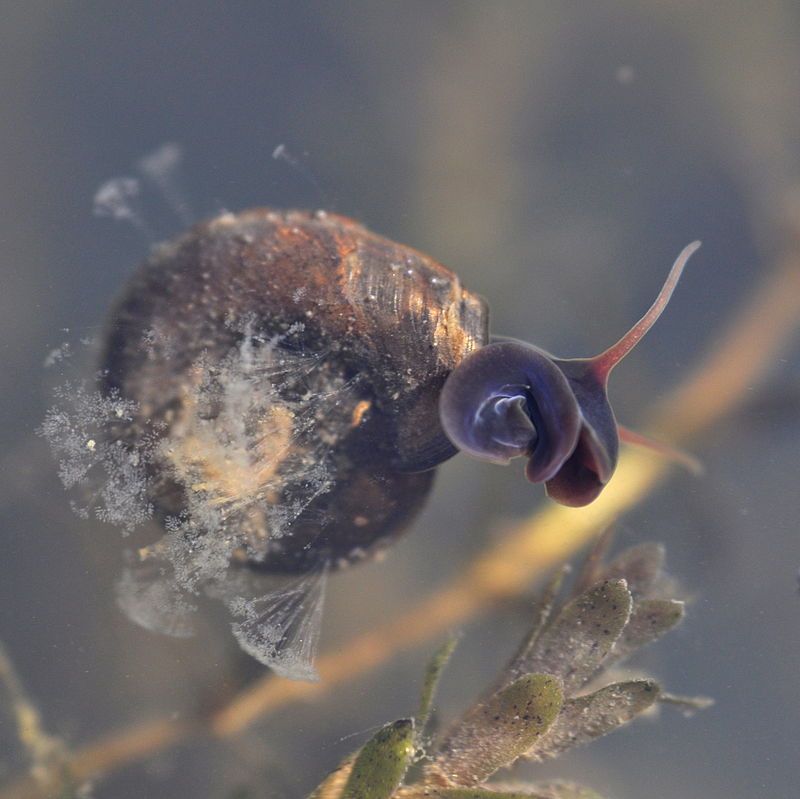
_2011-05-12.jpg)
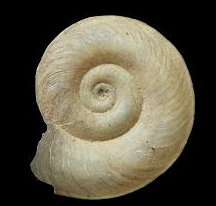
_vortex_(Planorbidae),_Gouderak,_the_Netherlands_-_2.jpg)
_vortex_(Planorbidae),_Gouderak,_the_Netherlands.jpg)
Left: Great ramshorn snail Planorbarius corneus, with to its right the equally common Lymnaea stagnalis. Right: the margined ramshorn snail Planorbis planorbis
Mud snail Bithynia tentaculata Showing the operculum
Biology
Read about the general biology of gastropods in our introductory page here. Pond snails graze on algae and eat dead plant and animal material in the pond using their radula . Lymnaea stagnalis is often seen at the top of the pond, feeding upside-down on material trapped at the surface meniscus.
Freshwater snails can remain active all year round but retreat into the lower depths of a pond during the winter months. Like land snails, pond snails produce a slimy mucus from their bodies which helps to lubricate their movement over objects in the pond, but in much smaller quanities.
Snail shells are made primarily of calcium carbonate, so there is likely to be a greater diversity of pond snails in lime-rich waters, and pond molluscs may be absent in pools with very acidic water.
Life cycle
Freshwater snails are hermaphrodite animals that pair up to mate and exchange semen. Eggs are laid in tubes or blobs of jelly attached to plants or the sides of ponds. The eggs hatch into small versions of the adult animal.
Role of pond snails in gardens
Freshwater snails are mainly scavengers that feed on algae, plant debris and other detritus in ponds and are part of a healthy pond ecosystem Pond snails are sometimes sold as a means of reducing excessive algal growth in ponds, but it is unlikely that they are of much benefit in this respect. Algal blooms are due to a combination of nutrient-rich water and warm temperatures. When these conditions occur, algae will grow much faster than pond snails are able to eat them.
Reference:
1. Anderson, R. 2005, An Annotated List of the Non-Marine Mollusca of Britain and Ireland, Journal of Conchology, London, 38:607-638.
Other sources of information
Books
Fitter, R. and Manuel, R. 1986 Collins Field Guide ro Freshwater Life William Collins and Sons
Dobson, M. et al (2012) Guide to freshwater invertebrates. Freshwater Biological Association Publication #68
Olsen , L-H. et al (2001) Small Freshwater Creatures. Oxford University Press
Rowson et al (2021) Freshwater snails AIDGAP Field Studies Council ISBN 9781908819581
Website
Website of the Conchological Society of Great Britain and Ireland
Brian Evesham's guide to freshwater molluscs
Page drafted by Andrew Halstead, reviewed by Andrew Salisbury, extended and compiled by Steve Head
Left: keeled ramshorn Planorbis carinatus shell. Right: two views of the whirlpool ramshorn Anisus vortex
Elongate pond snails
Other snails have upright shells much taller than wide, such as the very common Lymnaea stagnalis which grows to 50mm long and the smaller Lymnaea palustris which is less pointed. The wandering pond snail Radix balthica grows to 20mm or more in length, and has a very wide aperture that distinguishes it from the Lymnaea species. The bladder snail Physa fontinalis is a semi-aquatic species that often climbs up out of ponds and can be seen on the foliage of plants growing in pond margins. It is up to 12mm long, with a very large opening and thin translucent shell. Its main distinction is being sinistral in coiling, so when you hold with the point of the shell facing away from you, the aperture is on the left of the shell. Almost all other gastropods are dextral so their aperture is on the right.
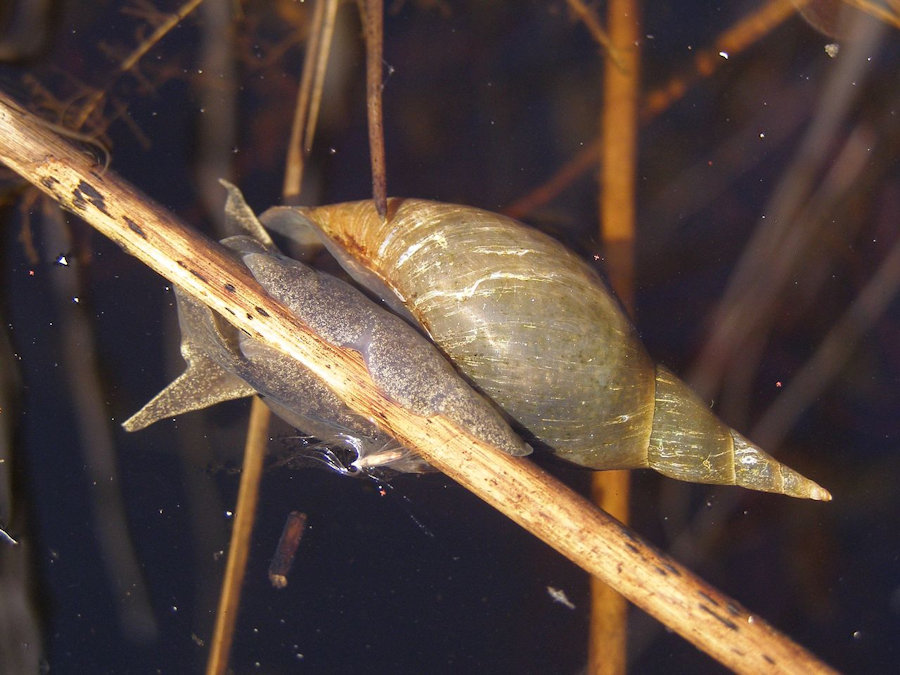
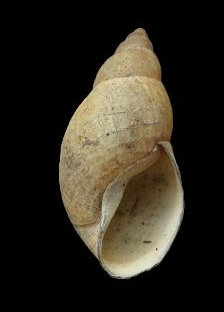
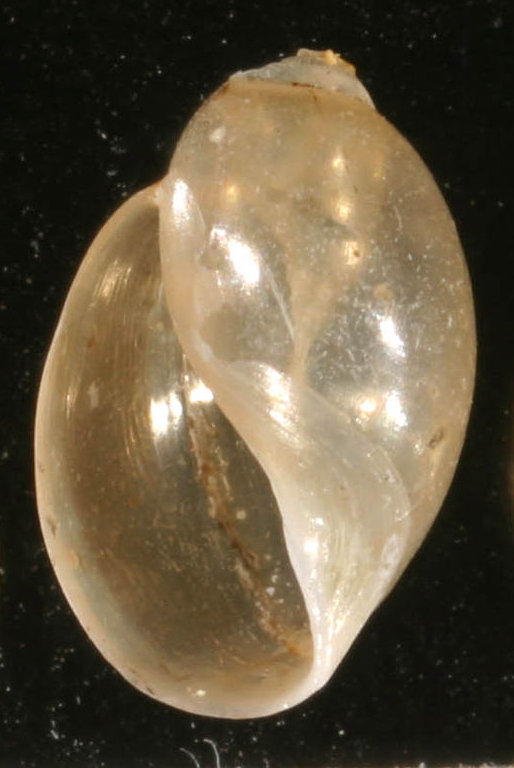
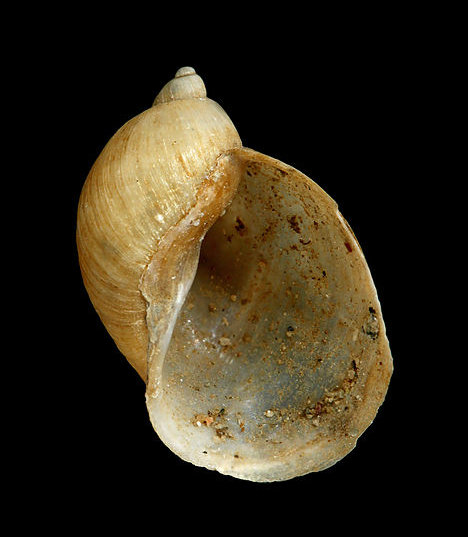
Left: Great pond snail Limnaea stagnalis Right: Shell of marsh pond snail Lymnaea palustris
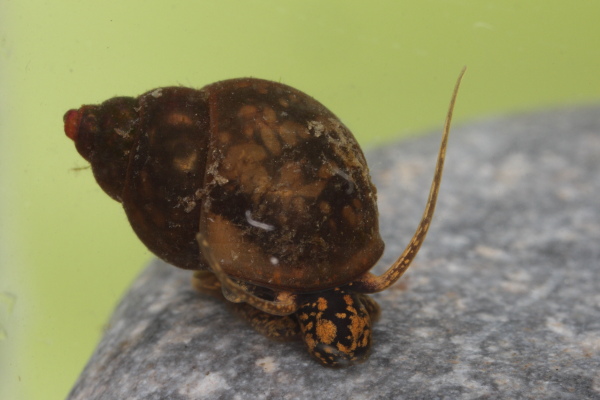
_0241_(38809559102).jpg)
Pond snails
While there are no pond slugs in the British Isles, there are a number of freshwater snails that occur in ponds.
Species in Britain and Ireland
Freshwater molluscs are of two types. The bivalves are covered on our page here. Gastropod snails are similar to terrestrial snails, having shells with an opening on the bottom from which the animal’s head and foot can be extended.There approximately 46 species of freshwater snail in Britain and Ireland1. Some live in streams and rivers but others can be found in still water, including garden ponds.
Pond snails come in two shell shape varieties, flat and relatively elongate or upright.
Flat or ramshorn snails
The distinctively shaped ramshorn snails are in the family Planorbidae coil in an almost flat spiral and are much wider than their height. There are several species which can be very hard to distinguish. The great ramshorn snail Planorbarius corneus is the commonest and largest, growing up to 35mm. The margined ramshorn Planorbis planorbis is up to 18mm, and the keeled ramshorn Planorbis carinatus grows to 14mm, and has a pronounced ridge or keel along the centre line of the coiled shell. These snails all have rather loosely coiled shells, but the whirlpool ramshorn Anisus vortex is tightly coiled and narrow in section, with a shell 7-10mm in diameter.
Pond snails
While there are no pond slugs in the British Isles, there are a number of freshwater snails that occur in ponds.
Species in Britain and Ireland
Freshwater molluscs are of two types. The bivalves are covered on our page here. Gastropod snails are similar to terrestrial snails, having shells with an opening on the bottom from which the animal’s head and foot can be extended.There approximately 46 species of freshwater snail in Britain and Ireland1. Some live in streams and rivers but others can be found in still water, including garden ponds.
Pond snails come in two shell shape varieties, flat and relatively elongate or upright.
Flat or ramshorn snails
The distinctively shaped ramshorn snails are in th family Planorbidae coil in an almost flat spiral and are much wider than their height. There are several species which can be very hard to distinguish. The great ramshorn snail Planorbarius corneus is the commonest and largest, growing up to 35mm. The margined ramshorn Planorbis planorbis is up to 18mm, and the keeled ramshorn Planorbis carinatus grows to 14mm, and has a pronounced ridge or keel along the centre line of the coiled shell. These snails all have rather loosely coiled shells, but the whirlpool ramshorn Anisus vortex is tightly coiled and narrow in section, with a shell 7-10mm in diameter.
_2011-05-12.jpg)

Left: Great ramshorn snail Planorbarius corneus, with to its right the equally common Lymnaea stagnalis. Right: the margined ramshorn snail Planorbis planorbis

_vortex_(Planorbidae),_Gouderak,_the_Netherlands.jpg)
_vortex_(Planorbidae),_Gouderak,_the_Netherlands_-_2.jpg)
Left: keeled ramshorn Planorbis carinatus shell. Right: two views of the whirlpool ramshorn Anisus vortex
Elongate pond snails
Other snails have upright shells much taller than wide, such as the very common Lymnaea stagnalis which grows to 50mm long and the smaller Lymnaea palustris which is less pointed. The wandering pond snail Radix balthica grows to 20mm or more in length, and has a very wide aperture that distinguishes it from the Lymnaea species. The bladder snail Physa fontinalis is a semi-aquatic species that often climbs up out of ponds and can be seen on the foliage of plants growing in pond margins. It is up to 12mm long, with a very large opening and thin translucent shell. Its main distinction is being sinistral in coiling, so when you hold with the point of the shell facing away from you, the aperture is on the left of the shell. Almost all other gastropods are dextral so their aperture is on the right.


Left: Great pond snail Limnaea stagnalis Right: Shell of marsh pond snail Lymnaea palustris


Shell of wandering snail Radix balthica Shell of bladder snail Physa fontinalis
The last species we are covering is the 12-15mm mud snail Bithynia tentaculata. All the other species so far have been "pulmonates" - the group of air-breathing gastropods that dominate the land and they have evolved from land-living species. Bithnyia is different, it is a not a pulmonate, but a member of a highly successful mainly marine group and is related to the seaside winkles. In consequence it has a horny pad, called an operculum, that it uses to close the shell opening after the animal has withdrawn into its shell. It is common in ponds, lakes and canals, but not apparently yet definitively reported from garden ponds - so look out for it! The operculum makes it easy to recognise.

_0241_(38809559102).jpg)
Mud snail Bithynia tentaculata Showing the operculum
Biology
Read about the general biology of gastropods in our introductory page here. Pond snails graze on algae and eat dead plant and animal material in the pond using their radula. Lymnaea stagnalis is often seen at the top of the pond, feeding upside-down on material trapped at the surface meniscus.
Freshwater snails can remain active all year round but retreat into the lower depths of a pond during the winter months. Like land snails, pond snails produce a slimy mucus from their bodies which helps to lubricate their movement over objects in the pond, but in much smaller quanities.
Snail shells are made primarily of calcium carbonate, so there is likely to be a greater diversity of pond snails in lime-rich waters, and pond molluscs may be absent in pools with very acidic water.
Life cycle
Freshwater snails are hermaphrodite animals that pair up to mate and exchange semen. Eggs are laid in tubes or blobs of jelly attached to plants or the sides of ponds. The eggs hatch into small versions of the adult animal.
Role of pond snails in gardens
Freshwater snails are mainly scavengers that feed on algae, plant debris and other detritus in ponds and are part of a healthy pond ecosystem Pond snails are sometimes sold as a means of reducing excessive algal growth in ponds, but it is unlikely that they are of much benefit in this respect. Algal blooms are due to a combination of nutrient-rich water and warm temperatures. When these conditions occur, algae will grow much faster than pond snails are able to eat them.
Reference:
1. Anderson, R. 2005, An Annotated List of the Non-Marine Mollusca of Britain and Ireland, Journal of Conchology, London, 38:607-638.
Other sources of information
Books
Fitter, R. and Manuel, R. 1986 Collins Field Guide ro Freshwater Life William Collins and Sons
Dobson, M. et al (2012) Guide to freshwater invertebrates. Freshwater Biological Association Publication #68
Olsen , L-H. et al (2001) Small Freshwater Creatures. Oxford University Press
Rowson et al (2021) Freshwater snails AIDGAP Field Studies Council ISBN 9781908819581
Website
Website of the Conchological Society of Great Britain and Ireland
Brian Evesham's guide to freshwater molluscs
Page drafted by Andrew Halstead, reviewed by Andrew Salisbury, extended and compiled by Steve Head












